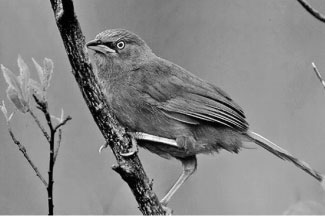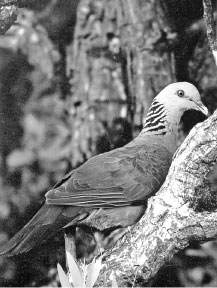Glimpses of Hill Birds
by K.G.H. Munidasa
A previous weekend, during a visit to the lower Hill Zone, I found
myself at a small village, tucked among forested foot-hills, close to
the western boundary of the Peak Wilderness.
It was almost dusk when I arrived at a friend's house that was in a
fold of the steep hillside, overlooking a green valley studded with
chena clearings.
 |
|
Rufous Babbler |
Incidentally, my host was a bird student of some standing, hence
among other matters of interest discussed at dinner that night, was the
subject of hill birds which were to be found around the place.
We dwelt on this topic at length until it was time to retire for the
night.The following morning, in spite of the prevailing inclement
weather, there were many birds about, and I heard many a strange call in
the forest bordering the village.
Bulbuls
The first birds which I notice were the yellow-browed Bulbuls. A pair
of these arrived in a cinnamon tree in the compound to look for their
breakfast of purple berries while the sun was still a long way below the
crest of the Sacred Mountain.
They uttered a series of loud and musical whistling notes, some of
which were very reminiscent of the forest or Black Bulbul, the most
typical of the hill country. Throughout my brief stay there, I was to
hear these mellow notes over and above the calls of the other birds in
the neighbouring countryside.
An endemic species likely to be met with in that terrain is the
Ceylon Yellow-eared Bulbul, a typical highland bird. I observed parties
of the Black Bulbul flying across from one hill top to another,
incessantly calling to one another in a raucous but pleasant voice.
Pre-tee Dear
The brown-capped Babbler was another endemic species I noticed during
my sojourn in the foothills. This shy jungle bird, known to the ordinary
villager as Redhi-Diyan and identified in bird circles by the name
"Pre-tee Dear" (both onomatopoeic renderings of its call) is found in
all three climatic tracts of the island, in three separate races.
During the two days I spent there, I heard this babbler regularly in
the early morning and then around five o'clock in the evening, calling
monotonously for long periods from the same patch of forest. Although I
did not attempt to flush one out of its damp, shady retreat for a closer
view, I was certain it was the dark form which inhabited the wet zone
forests.
To be judged by the sundry squeaks and chatterings heard beside
tracks through the shrubbery the place was well represented by the
babbler family Timalinae. I could make out the churring notes of the
white-throated and Black-fronted Babblers, foraging under cover.
Further I had a passing glimpse of the Ceylon Scimitar Babbler
Pomatorhinus horsfieldii melanurus, one of the wariest in the family.
This could be the wet zone race one often met at the foot-hills.
In one of my previous visits to the place, couple of years ago, I had
come across a solitary Rufous Babbler-(believe it or not) in a flock of
the common Ceylon Babbler or "Seven Sisters". I could not but speculate
as to how this alliance was brought about.
Hunting party
The shrikes (Campephagidae) cuckoo shrikes and minivets were birds of
the forest canopy. In one mixed hunting party I came upon in precipitous
slopes, I observed family groups of the Orange Minivet, Small Minivet,
Velvet-fronted Blue Nuthatch, Pied Shrike and a pair each of the
gold-fronted Chloropsis and the pigmy woodpecker, with one or two
crested Drongos in attendance. The whistling of black-headed
Cuckoo-Shrike was heard in a cluster of trees, beyond.
 |
|
Wood Pigeon |
As was usual in well-wooded areas of both the wet and the dry zones,
pairs of the rarer large cuckoo-shrike passed overhead uttering their
"kur-eech" call.
The Ceylon Lorikeet, I noticed, was commoner there than in the
lowland proper, while wild chattering of the blossom-headed parakeet was
heard at every hour in daytime.
The white bellied race of the common Ceylon Drongo paused on branches
of dead trees beside the track, on the lookout for insect prey. A large
pigeon-like bird up in a high forest tree on being studied with my
binoculars, was tentatively identified as the Ceylon wood pigeon or lady
Torrington's pigeon, an endemic species peculiar to the mountain zone.
This wood pigeon might be overlooked by the average bird-watcher,
owing to its close resemblance to the Green Imperial Pigeon of the
lowlands, but the chessboard mark on the back of its neck should dispel
any doubts about its identity.
There could have been other fruit pigeons in the thick foliage but I
failed to spot any.
The Emerald Dove, however, was there, single or in pairs, walking the
lonely stretches of the track under the shade of the forest.
Endemic birds
Yet another endemic species I noted was the Ceylon yellow-fronted
Barbet. Its call started in a long drawn cruuuuuu and then changed to
kruik, kruik, kruik was one of the most prominent bird-calls heard in
the hill slopes, as several barbets begin to call in unison. Though the
larger brown-headed Barbet was there I did not spot the other two
species.
I could have mistaken the Ceylon white-eye for a female Common Iora
had I not noticed the white ring round the formers eyes. This, after all
is a resident of the higher elevations, apparently come down to the
lower level in response to the prevailing weather.
I was certain I spotted a yellow-naped Green Woodpecker in a standing
tree trunk, and subsequently heard its unmistakable queer call in the
heart of the forest.
The black-headed Orioles had nested lately at the edge of the garden
and the family with a single young were pointed out to me by my fried,
sitting on the branches of a Jak tree, opposite the compound.On bare
dead branches of trees leaning out from the forest margins perched
crested Tree-Swifts and Ashy Swallow-Shrikes.
|


